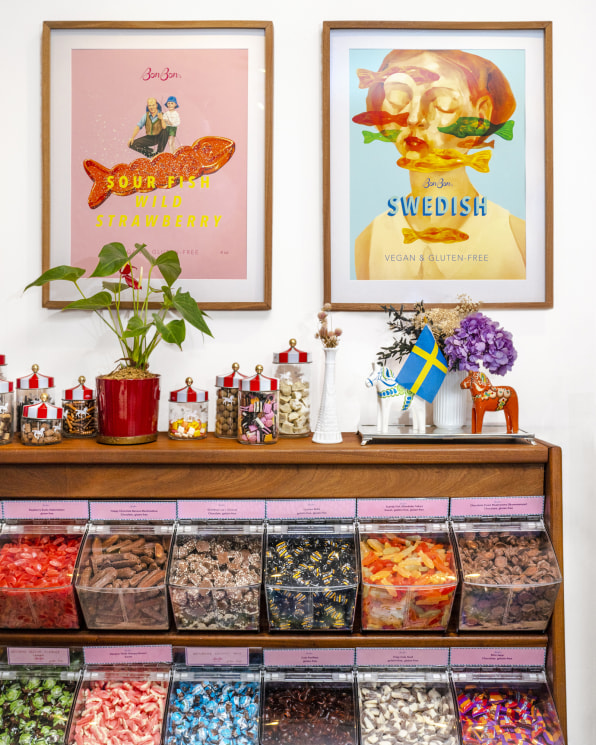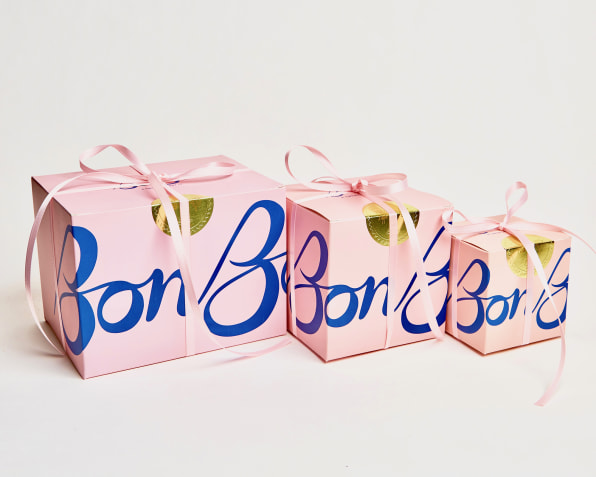[ad_1]
In addition to giving us IKEA, meatballs, and the supergroup Abba, Sweden made yet another contribution to our general happiness: pick-and-mix candy. It’s a tradition that best friends and fellow Swedish immigrants, Robert Persson, Selim Adira, and Leo Schaltz had in mind when they opened BonBon, their Swedish candy store on Manhattan’s Lower East Side. With unlimited sampling from over 160 different Scandinavian candies clearly displayed in old-fashioned bulk bins, BonBon NYC makes good on its motto: Growing up is a trap.
“Sweden has an enormous candy culture. It’s in our childhood DNA, and you don’t understand the magnitude of your candy relationship until you move away—like Italians and pasta, French and baguettes, or Americans and peanut butter,” says Adira. “So, we obsessed over BonBon’s store design as a home-away-from-home for Scandinavians in the U.S. while introducing Swedish candy, and everything it represents, to a city as diverse as New York.”
According to Jordbruksverket, the Swedish Board of Agriculture, Swedes are the world’s largest candy consumers (nearly 35 pounds per person annually), and the 1950s-era government attempt at moderation of setting aside one day a week to enjoy candy, called lördagsgodis (“Saturday sweets”) is a family ritual that continues to shape their culture.

Pick-and-mix also has a practical element: Swedish parents use the candy as a learning tool, teaching children how to budget from their allowances. “We love watching the weighing game as the children analyze all the bins, fill their bags, and then come up to the counter to weigh,” says Adira. “It’s a really great way for kids to learn some independence and budgeting.”
The pick-and-mix ritual is one reason the BonBon partners continue to prioritize brick-and-mortar locations. (In addition to Manhattan’s Lower East Side, BonBon has opened stores in Williamsburg, Brooklyn, and on the NYC’s Upper East Side.) But another is that an e-commerce-only business would not allow customers to sample candy that’s hard to find in the U.S., such Nordic salty black licorice. “Candy is romantic, it’s nostalgic, and there’s something about going to a candy store to treat yourself and others with favorite sweets,” Adira says.
When the pandemic forced the partners to transition their operations to delivery apps, BonBon began offering a range of candy in individual four-ounce portions, easier for those more familiar with buying one candy by the scoop. “We wanted to make the add-to-cart easier with pre-portioned single selections,” Adira says.
Selling through the apps also yields helpful customer insights, like order frequency or surge delivery periods. Adira says BonBon sees surges after lunchtime, between 2 and 3 p.m., and then again after dinnertime, between 8 and 10 p.m. And not just requests for deliveries, but store visits, too. “That’s why we stay open so late,” he says. “Candy until midnight seven days a week is our New York City tradition.”
In Spring of 2023 BonBon, introduced its first pre-packaged product, a line of classic Swedish fish candies in five flavors: Sweet Wild Strawberry, Sour Wild Strawberry, Sour Elderberry, Sour Blackberry, and Sour Peach. The partners call the flavor “intelligent sour,” subtle and still enjoyable. “We don’t want to burn our taste buds with the acidity you get from too sour,” says Aldira. “If we destroy our tongues, how will we keep on eating candy?”

Swedish fish are a bona fide cult candy—an old viral Reddit thread claimed that you got better service when sending in devices for hardware repair if you included a package of that candy, known as the Swedish Fish Theory. “Although we are Swedish and our fish candy is produced for us in Sweden, we do not call out or mention Swedish Fish in our packaging. This our version—BonBon Fish,” says Adira.
The non-GMO candy has no trans fats and is made with natural colorants such as black carrots, herbs and fruits, real sugar (not high fructose corn syrup); it’s vegan and gluten free. The wax-lined biodegradable packages with distinctly Scandinavian illustrations by Swedish painter Simon Dahlgren Strååt, inspired by the fantastical patterned textiles of SvensktTenn designers Estrid Ericson and Josef Franks (who also designed the furnishings in BonBon stores), include stories of the partners’ childhoods, reflecting how personal candy is to them and how vital to Swedish cultural life.
“When we first started this business, it became apparent to us that Americans make a connection between eating candy and health. But for Swedes that connection is cultural. We go about eating our candy in moderation, even on lördagsgodis, and we do it with great joy,” says Adria. Despite its conspicuous consumption of sweets, Sweden consistently ranks near the top of various world’s healthiest countries lists, such as the Bloomberg Global Health Index.
Because pick-and-mix is not easy to sell in locations other than their own stores, the creation of BonBon fish is a way of getting their brand out into the world through wider distribution channels. The partners work with over 200 independent retailers, including Chicago-based Foxtrot, the digital platform adding national brick-and-mortar locations with a mission to reimagine the corner convenience store by carrying both the everyday and the artisanal. “We are sold in most Foxtrot locations, where we have one of our biggest retail presences and love how well that brand showcases candy,” says Adira. They also sell their BonBon fish at all MOMA stores and in boutique hotels such as The Mercer, The Ludlow, The Wythe Hotel (in Williamsburg, Brooklyn), Soho House, and the Moxy hotel brand, part of the greater Marriott family.
Ultimately, Adira and his partners are attempting to import the particular joy Swedes associate with their candy. “Our winters can be so dark, a bit depressing,” Adira says, “and we look for lifts in the day. A bit of candy keeps us motivated and moving. At BonBon, it’s always Saturday.”
Francine Maroukian, a two-time James Beard Award winner, is a food and travel writer who also works as an operative researcher for C-suite executives in big retail.
[ad_2]
Source link

